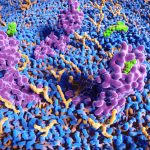Breast Cancer Prevention: Considerations for High-Risk Women
Lise Alschuler, ND, FABNO
As a breast cancer survivor and a doctor who often treats high-risk women, this is a subject to which I pay very close attention. Because of the prevalence of breast cancer, regardless of your clinical focus, it’s likely that you have had a patient (or perhaps many patients) ask your advice about risk and ways to reduce that risk. The first step in communicating with these patients is helping them understand the levels of risk.study conducted by Johns Hopkins Bloomberg School of Public Health late last year indicated that 3 weeks following Angelina Jolie’s announcement about her BRCA status and prophylactic surgery, people were confused about breast cancer risk and the genetic link.1 Although 3 out of 4 women surveyed knew about Jolie’s decision, the researchers found that they still did not understand their own risk. While announcements such as Jolie’s raise awareness about breast cancer in general, they have done little to delineate between the 3 categories of purported high risk: genetic mutation, family history, and survivorship risk of recurrence (contralateral breast cancer).
No Easy Answers
There is no doubt that women who carry a BRCA1 or BRCA2 genetic mutation have a significantly higher risk of developing breast cancer. Percentages vary, but most studies demonstrate that the lifetime risk of breast cancer in a woman with these mutations is anywhere from 45-80%.2 Lifetime risk of breast cancer in a woman without a BRCA mutation is about 12%. Only about 10% of all breast cancers can be attributed to a BRCA genetic mutation. This means that 90% of all breast cancers are caused by other acquired factors.
Family history plays a role in risk but is not nearly as significant as a BRCA genetic mutation. In the Jolie follow-up study, about half of the participants incorrectly thought that lack of family history meant they had a lower than average personal risk. The fact is, only about 15% of women who are diagnosed with breast cancer have a family history.3 It’s important to explain to patients that family history represents an increased susceptibility but this is mostly due to epigenetic factors, ie, factors that can be modified to potentially reduce this predisposition. More on that in a moment…
Most women with unilateral breast cancer will not develop contralateral breast cancer during their lifetimes.4 Risk of developing contralateral breast cancer in female survivors without a BRCA mutation is actually quite low, with the incidence reported as up to 3%.5 In 2012, research using SEER data involving more than 109 000 women with a primary diagnosis of unilateral breast cancer found that 4 years after diagnosis, less than 1% of the women had developed contralateral breast cancer.6 Those researchers concluded that breast cancer risk in breast cancer survivors is “highly overestimated.”
When I counsel patients who are fearful of developing breast cancer due to their high-risk status, I first attempt to stratify their risk. This allows us to better evaluate the most effective options and the desired level of aggressiveness in a proactive prevention plan. This becomes particularly relevant when discussing the issue of prophylactic mastectomy. While surgery is a highly personal decision, it is important that women consider this option from a place of empowerment and are not motivated solely by fear.
While the topic of prophylactic mastectomy is too vast for the scope of this article, a few assertions can be made. Purely from an evidence-based perspective, the only women who can expect a statistically significant reduction in the risk of contralateral breast cancer as a result of prophylactic mastectomy are women with a BRCA mutation. Bilateral prophylactic mastectomy is associated with a risk reduction of 90-95% of developing primary or contralateral breast cancer in BRCA mutation carriers, especially in women diagnosed at a young age with the first breast cancer.7 In all other women, the impact of prophylactic mastectomy on overall survival is negligible, even after controlling for confounders such as oophorectomy.8 In one recent analysis, the absolute 20-year survival benefit from contralateral prophylactic mastectomy was less than 1% among women of all ages, estrogen receptor (ER) status, and cancer stage groups.9 However, women who undergo prophylactic mastectomy do consistently report a reduction of fear of recurrence, which is significant and should be taken into account. While mastectomy is often the most sought-after risk reduction strategy, this is typically offered along with bilateral oophorectomy and/or systemic estrogen receptor blocking therapy (selective estrogen receptor modulator, or SERM) or aromatase inhibitor therapy (selective estrogen enzyme modulator, or SEEM). Given the potential adverse effects of this conventional approach, natural and lifestyle-based risk reduction strategies should be considered.
Emphasizing Epigenetics
Accepting lifestyle as a powerful prevention tool requires an appreciation for the influence of epigenetics in carcinogenesis. There are 2 important aspects of epigenetics in high-risk women. A dysfunctional BRCA gene is a germline mutation that is present from conception. Therefore, the consequences of a mutation in this key cell repair gene, BRCA, accumulate over time, starting at conception. That means that the phenotypic result of BRCA mutation occurs after an extended period of time and under a multitude of influences. Paired with this understanding is the fact that cellular activity is characterized by a certain degree of redundancy, including cell repair. Thus, the clinical consequences of a mutation in the BRCA gene are not only variable and modifiable, they are also dependent upon the ongoing status of cell repair in a more global sense. The transcription of cell repair genes and the activity of their cell repair proteins are epigenetically influenced. In fact, we know that cellular interaction with external food and biochemical environments has significant influence on our genetic expression.
In women with a BRCA mutation, observational studies suggest that when BRCA mutation carriers eat more fruits and vegetables, they significantly reduce their risk of developing cancer, despite their BRCA status.10,11 The same is true for obesity. Women who are BRCA-positive and maintain normal body weight and prevent weight gain lower their risk of cancer despite being at high risk. This is particularly true for younger women. A matched case-control study of over 1000 pairs of BRCA mutation carriers found that weight loss in early adult life (age 18 to 30) protects against early-onset BRCA-associated breast cancers.12 There is emerging evidence that IGF-1, commonly elevated in obesity, is a significant factor in increasing BRCA mutation clinical penetrance.13
Applying General Prevention Strategies
Painting the concept of risk reduction with a broader brush yields a veritable cornucopia of prevention strategies. In addition to a diet emphasizing fruits and vegetables and maintaining normal body weight, studies indicate that a Mediterranean-type diet, in particular, with its focus on healthy fats and lean meats can help reduce risk of most cancers, including breast.14 A noteworthy characteristic of the Mediterranean diet is its high polyphenol content.
While not specific to high-risk women, studies have demonstrated that polyphenols can convey considerable protective effects against cancer. Many of these substances have been shown to stimulate apoptosis (cell suicide) of aberrant cells, to exert immunomodulatory effects, impede tumor invasiveness, and inhibit angiogenesis. Polyphenolic catechins found in green tea, for example, have been shown to reduce breast cancer risk in human clinical trials.15 Curcumin, a polyphenolic from turmeric, has been shown in both in-vitro and in-vivo studies to exert a profound anti-breast cancer effect due to its actions on many critical genes associated with angiogenesis, apoptosis, cell cycle, and metastasis.16 The consumption of soy isoflavones is inversely correlated with both breast cancer risk and risk of recurrence.17 Additional preventive polyphenolic compounds include, but are not limited to, Polygonum cuspidatum extract (an effective source of trans-resveratrol), quercetin, and black cohosh extract.
Of course, lifestyle factors such as sleep, stress management, and physical activity have well-documented cancer preventive effects. A recent prospective, randomized clinical trial demonstrated that the combination of regular moderate aerobic exercise combined with a reduced-calorie weight loss diet resulted in a 22% decreased risk of breast cancer in postmenopausal women.18 To reduce risk of breast cancer, the current national recommendation is 150 minutes of moderate-intensity exercise or 75 minutes of vigorous exercise each week. This level of exercise reduces the risk of dying from breast cancer in breast cancer survivors by as much as 60%.19
The Mediterranean diet combined with targeted dietary supplements and regular exercise provides synergistic epigenetic influence that can significantly alter the risk profile for even high-risk patients.
The Healing Power of Hope
Fear can be paralyzing while hope can be freeing. One of the most important roles we can play with this patient population is to transform their fear into hope – not false hope, but, instead, a hope that is founded upon logical, scientifically-based rationale. Women at high risk for breast cancer deserve a carefully considered approach that optimizes genetic expression and cellular function to reduce breast cancer risk.
 Lise Alschuler, ND, FABNO, received her naturopathic doctorate from Bastyr University and is board-certified in naturopathic oncology. She currently practices at Naturopathic Specialists in Scottsdale, AZ, and is the president of the Oncology Association of Naturopathic Physicians. She is the co-author of several books including her latest: The Definitive Guide to Thriving After Cancer. She is the co-creator of the Five to Thrive Plan and also co-hosts a radio show on the Cancer Support Network, which is also available on iHeart.com.
Lise Alschuler, ND, FABNO, received her naturopathic doctorate from Bastyr University and is board-certified in naturopathic oncology. She currently practices at Naturopathic Specialists in Scottsdale, AZ, and is the president of the Oncology Association of Naturopathic Physicians. She is the co-author of several books including her latest: The Definitive Guide to Thriving After Cancer. She is the co-creator of the Five to Thrive Plan and also co-hosts a radio show on the Cancer Support Network, which is also available on iHeart.com.
References
- Borzekowski D, Guan Y, Smith KC, et al. The Angelina effect: immediate reach, grasp, and impact of going public. Genet Med. 2014;16(7):516-521.
- Bougie O, Weberpals JI. Clinical considerations of BRCA1 and BRCA2 mutation carriers: a review. Int J Surg Oncol. 2011;2011:374012.
- What are the risk factors for breast cancer? Last updated September 25, 2014. American Cancer Society Web site. http://www.cancer.org/cancer/breastcancer/detailedguide/breast-cancer-risk-factors. Accessed November 2, 2014.
- Bedrosian I, Hu CY, Chang GJ. Population-based study of contralateral prophylactic mastectomy and survival outcomes of breast cancer patients. J Natl Cancer Inst. 2010;102(6):401-409.
- Herrinton LJ, Barlow WE, Yu O, et al. Efficacy of prophylactic mastectomy in women with unilateral breast cancer: a cancer research network project. J Clin Oncol. 2005;23(19):4275-4286.
- Uyeno L, Behrendt, Vito C: Contralateral breast cancer: Impact on survival after unilateral breast cancer is stage-dependent. 2012 Breast Cancer Symposium. Abstract 69. Presented September 14, 2012.
- Nestle-Krämling C, Kühn T. Role of Breast Surgery in BRCA Mutation Carriers. Breast Care (Basel). 2012;7(5):378-382
- Lostumbo L, Carbine NE, Wallace J. Prophylactic mastectomy for the prevention of breast cancer. Cochrane Database Syst Rev. 2010 Nov 10;(11):CD002748.
- Portschy PR, Kuntz KM, Tuttle TM. Survival outcomes after contralateral prophylactic mastectomy: a decision analysis. J Natl Cancer Inst. 2014;106(8). pii:dju160.
- Nkondjock A, Ghadirian P. Diet quality and BRCA-associated breast cancer risk. Breast Cancer Res Treat. 2007;103(3):361-369.
- Ghadirian P, Narod S, Fafard E, et al. Breast cancer risk in relation to the joint effect of BRCA mutations and diet diversity. Breast Cancer Res Treat. 2009;117(2):417-422.
- Kotsopoulos J, Olopado OI, Ghadirian P, et al. Changes in body weight and the risk of breast cancer in BRCA1 and BRCA2 mutation carriers. Breast Cancer Res. 2005;7(5):R833-R843.
- Pasanisi P, Bruno E, Manoukian S, Berrino F. A randomized controlled trial of diet and physical activity in BRCA mutation carriers. Fam Cancer. 2014;13(2):181-187.
- de Lorgeril M, Salen P. Do statins increase and Mediterranean diet decrease the risk of breast cancer? BMC Med. 2014;12:94.
- Wu AH, Yu MC, Tseng CC, et al. Green tea and risk of breast cancer in Asian Americans. Int J Cancer. 2003;106(4):574-579.
- Nagaraju GP, Aliya S, Zafar SF, et al. The impact of curcumin on breast cancer. Integr Biol (Camb). 2012;4(9):996-1007.
- Nechuta SJ, Caan BJ, Chen WY, et al. Soy food intake after diagnosis of breast cancer and survival: an in-depth analysis of combined evidence from cohort studies of US and Chinese women. Am J Clin Nutr. 2012;96(1):123-132.
- Campbell KL, Foster-Schubert KE, Alfano CM, et al. Reduced-calorie dietary weight loss, exercise, and sex hormones in postmenopausal women: randomized controlled trial. J Clin Oncol. 2012;30(19):2314-2326.
- Ballard-Barbash R, Friedenreich CM, Courneya KS et al. Physical activity, biomarkers, and disease outcomes in cancer survivors: a systematic review. J Natl Cancer Inst. 2012;104(11):815-840.










